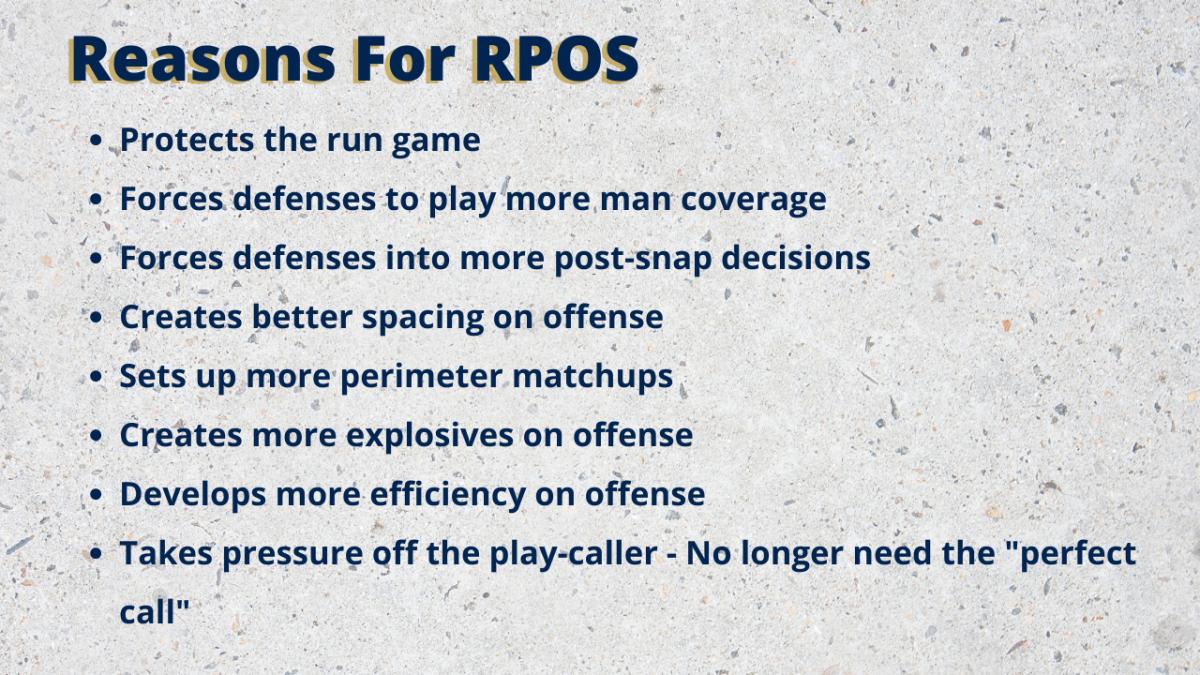RPO 101 - What They Are, How They Work, Why Notre Dame Needs Them
In the last four seasons Notre Dame has done well to establish an offense that is physical, built around its line and tight ends, and one that is effective running the football at a high level. Over the last four seasons the Fighting Irish offense has averaged 210.5 rushing yards per game, averaged 5.2 yards per attempt and the NFL is littered with Notre Dame linemen and tight ends.
Notre Dame has the necessary run game to be an elite offense, it has the line and tight end play to be great, it has the physicality to be great. It also has the defense to play for championships. Now the offense must develop a pass attack that is equally as dominant, and one that better supports the run game.
The very first thing Notre Dame must do is make RPOs a key ingredient of the offense. It’s not a play, it’s not something you call from time to time, it’s more of a philosophy than it is a play call. If it’s not at the heart of your offensive philosophy it won’t have the intended impact, especially against better opponents.
In this video I breakdown RPOs, how they work and why Notre Dame needs to use them. There is plenty of Xs and Os talk, including video to show how they work and why they are so effective. Those points are also discussed in the written text below the video.
Notre Dame has used RPOs in the past at times, and at times with a great deal of success. They were a key ingredient in the offense during much of the 2018 season after Ian Book took over the offense. In the nine games after Book was inserted into the lineup, with RPOs a key part of the offense, Notre Dame averaged 37.2 points per game, 486.3 yards per game and 6.53 yards per play.
Book averaged 306.9 passing yards per game, 8.9 yards per pass attempt and completed 70.0% of his throws, and a big part of that high completion rate was the effectiveness of the RPO offense. His QB rating that season in his starts was 162.06.
The RPOs were not nearly as big of a part of the offense in 2019 and at times weren’t used at all, and they were all but gone by 2020. During those two seasons the offense averaged just 35.2 points per game (33.4 in 2020), 439.5 yards per game and 6.26 yards per play. Book averaged just 234.6 passing yards per game and 7.8 yards per pass attempt, completed just 64.6% of his passes and had a QB rating of just 146.85.
Notre Dame also ran RPOs a lot in 2017, and through the first nine games they executed those plays quite well, which is why the Irish averaged 40.2 points per game, 495.1 yards per game and 6.7 yards per play ... against a schedule that contained four ranked opponents.
In the last four seasons Notre Dame has topped 600 yards of offense just three teams, and all three instances came during that nine-game start to the 2017 season. As the RPOs became less a part of the offense, the less effective the offense became.
This past season was his career lowest yards per game total, quarterback rating and fewest touchdowns per game average.
Not only are they needed back in, they must become more of a focal point than ever.
WHAT IS AN RPO?
RPO is the acronym for Run Pass Option.
On each play the quarterback has the following options:
- Hand the ball off
- Pull the ball after the mesh and throw it
- Pull the ball and starting running himself, and possibly throw it depending on the call
- Catch the snap and throw it quickly

It sounds like a lot, but it really isn’t. You also won’t have all five options on every play. Usually you’ll only have three of them, and often times just two.
WHY THEY ARE IMPORTANT
There are many reasons to run RPOs, but the reasons will vary team by team. Here are the reasons I believe Notre Dame, specifically, should run RPOs and the value they would bring to the offense.

RPO OPERATION
Here’s the basic operation of a RPO
- Play is called from the sideline
- Quarterback identifies his read key, which will be determined by the defense’s alignment and what the coaching point was during the week of preparation
- Offensive line and any players (RB, TE, WR) that are part of the run concept will block for the called run play no matter what
- Players tagged for pass execute their called routes no matter what
- Quarterback makes a read and performs one of the options discussed above
How it works is a run play is called. Unless the quarterback audible to something else, the offensive line, running backs and possibly the tight ends will block that called run. No matter what happens with the quarterback and wide receivers, the line is blocking the run and they won’t know if its actually a run or pass until the decision has been made and the ball it out or being run behind them.
The quarterback will identify his RPO read key, which is usually a linebacker or safety, depending on the defensive alignment and the route(s) that is tagged with the run call.
If the read key has vacated a certain zone the quarterback can catch the snap and immediately just throw the ball to the tagged receiver, assuming it’s a quick throw. Otherwise, the quarterback will receive the snap and start to go through the action of handing the ball off with his body while getting his eyes on the read key.
The quarterbacks coaching point will be simple, if that read key does A, you hand the ball off. If the read key does B you pull it and throw it. If a specific tag is made or if the game plan calls for it, he could pull it and starting running outside where he would then get his eyes on a second read key to determine if he’s going to keep it or throw it downfield.
There will always be flexibility within the calls that if the quarterback gets a look to the side of a called run he gives and doesn’t worry about the read for the pull. There are RPOs that are pass first options that involve quarterback runs, which we’ve seen at Notre Dame. A coach can also make a call from the sideline to the quarterback that locks him into the handoff or the pull, which comes as the offense gets more and more comfortable. When you have a veteran quarterback you can get into situations where you make a run call and the quarterback will alert the wideout(s) what route he wants based on his read of the defense presnap.
It is a relatively simple philosophy, but one that requires constant repetition to master, which is why it must be a core philosophy and not something you do from time to time, which is what it has been for Notre Dame in recent seasons.
The philosophy behind an RPO is more in line with the philosophy behind running the ball, which is why it is a must-have for a team that values running the football. In fact, I’d argue strongly that run-heavy teams like Notre Dame have a greater need for a strong RPO philosophy than do pass-heavy teams.
RPOs are about getting the ball in the hands of your playmakers, sure, but even more important they are a key part of winning the numbers game. That’s exactly what Notre Dame tries to do with its run game, and what opponents try to do to stop it. Adding effective RPOs to the run game only makes it harder to defend the run, and it makes your run game more efficient and more explosive.
Imagine Notre Dame running the ball right at opponents who are afraid to overcommit with numbers or their safeties for fear of having the ball throw outside or over their head or behind their linebackers and safeties.
It would be a tremendous addition to the offense, and would be the first huge step to getting the offense on an elite level.
To comment below be sure to sign up for a FREE Disqus account, which you can get HERE.
———————
Become a premium Irish Breakdown member, which grants you access to all of our premium content, our premium message board and gets you a FREE subscription to Sports Illustrated! Click on the link below for more
Be sure to stay locked into Irish Breakdown all the time!
Join the Irish Breakdown community!
Subscribe to the Irish Breakdown podcast on iTunes.
Subscribe to the Irish Breakdown YouTube channel.
Follow me on Twitter: @CoachD178
Follow me on Parler: @BryanDriskell
Like and follow Irish Breakdown on Facebook
